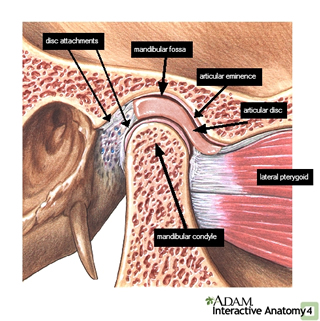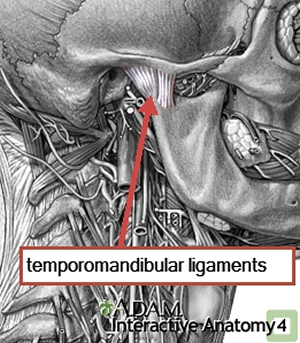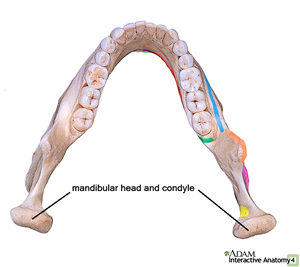Positive Health Online
Your Country

The Relevance of... the TMJ: Part I: A Little Bit of Anatomy to get your Teeth Into!
listed in anatomy and physiology, originally published in issue 159 - June 2009
We would have a hard time getting our teeth into anything if it wasn't for the beautifully arranged TMJ, or temporomandibular joint, so called from the articulation of the temporal bone and the mandible.
It a wonderfully unique joint, its structure cleverly allowing for three different groups of movements: the up and down, or elevation and depression, of the jaw, the pushing forward or protraction of the mandible (retraction being the drawing back) as well as some side to side motion, or lateral deviation. Find a mirror and experiment with the movements that are possible! Of course there is a TMJ either side of the jaw - two temporal bones, one mandible - so it is important that they both work, and together.

TMJ dysfunction, or TMD, is a general term used to refer to pain or discomfort in this area. As a complaint many CAM therapists come across, it is worth taking a look at some of the basic anatomy.
The clever feature of this joint is the articular disc that sits above the condyle of the mandible and below curved parts of the temporal bone, namely the mandibular (or articular) fossa and the articular eminence. When the mouth is closed the condyle sits in the fossa; as it opens the first 2cm it hinges in here, then the disc slides down the articular eminence as it hinges further. The concave underside of the disc enables the condyle of the mandible to continue to hinge, and take the body and angle of the mandible backwards, but stay in good alignment. (Try opening your mouth more than 2cm resisting any forward movement of the jaw - without any backward moving of the head either!)
The disc is attached loosely to the temporal bone at the front and back (enabling movement forward and back), and more tightly to the mandible at the back, (so it stays in the right place to hinge well). You can just see those attachments in the diagram.
But how does it move? It is also attached to one of the muscles involved in the jaw movement, the lateral pterygoid (ter-e-goid): the front of the disc to the muscle's upper fibres. It is this that draws it forward and down the articular eminence.
Often TMD problems are related to mal-positioning of the disc. It can get displaced too far forward, or too far back, not properly covering the head of the condyle as it moves. This can create clicking sounds and vibration that can be uncomfortable or even painful. A forward and medial displacement can be created from undue or unbalanced tension in this lateral pterygoid muscle; posterior displacements can be due to over-stretch in the posterior ligaments, so when the disc moves forward there is not enough pull to stop it going too far, it slips off the condyle and doesn't return to the correct alignment. There are a number of other variations on these themes - in short, disc alignment is really important!
The presence of the disc divides the joint cavity into two separate compartments; each contains synovial lining that produces synovial fluid, which helps to lubricate and cushion the joint. It also is vital for nourishing the disc which, being an avascular would not fare well on its own! Unusually, the cartilage lining the bones is not hyaline but fibrocartilage which can be re-made by cells below in response to stress on the bones. This ability does decrease as we age, so some TMJ problems can be due to wear or undue stress and tension on the bony arrangement.
The joint's movement pattern is also protected by the joint capsule and ligaments. The capsule is loose anteriorly and posteriorly, but tighter medially and laterally. The lateral side is reinforced by a ligament, the temporomandibular, restricting sideways movement. There are a couple of other complicated sounding ligaments that support the joint at its extended range of movement: the sphenomandibular and stylomandibular ligaments.

The sphenomandibular ligament runs from a little bump, the spine of the sphenoid, just inside the articular fossa, to the inside of the mandible, around the mandibular foramen, (the hole that the inferior alveolar nerve uses to give feeling to the lower teeth among other things). It is a little slack when the jaw is closed, but tightens when half open.
The stylomandibular ligament runs from the styloid process of the temporal bone (the long and pointed process medial to the external acoustic meatus or earhole), to the back edge of the body, nearly at the angle of the mandible. What does this ligament do? Some say not very much! Most say it must be involved in support of the joint but are not entirely sure at what point it kicks in.
Trauma or injury to the joint can result in damage to the ligaments and resulting TMJ problems over time. However, this is less common than disc problems.

Another aspect of the bony architecture of the joint I find interesting is the width of the mandibular condyles. Look at the image and see just how wide it is in relation to the rest of the head and neck of the bone. This gives a good and broad surface for the grinding, side to side movements of the jaw.
Next time we will look at the muscles around this joint and more about how it functions.
Acknowledgement Citation
Images from Adam Interactive Anatomy
Comments:
-
No Article Comments available